
Inflation and GDP in Focus
Last week, political and geopolitical events drove market movements, while economic data releases were relatively light. Outside the U.S., central banks in Australia and New Zealand cut interest rates, whereas the People’s Bank of China maintained record-low rates, shifting the focus to potential fiscal policies. In Europe, recently released data indicated weaker economic growth, despite a slight increase in PMIs.
Looking ahead, inflation data from major developed economies, along with GDP figures and ongoing geopolitical tensions, will be the key market drivers. On the economic calendar, key U.S. releases include New Home Sales (Wednesday), Durable Goods Orders (Thursday), and Personal Income & Spending (Friday). Internationally, GDP reports from India, Canada, Germany, Switzerland, Türkiye, and France, as well as inflation data from the Eurozone, will be in focus.
USA: Review and Expectations
Last week, the U.S. market was primarily influenced by geopolitical events and economic data. While better-than-expected economic reports and the Federal Reserve’s hawkish tone in its statement initially suggested a lower market close, geopolitical developments shifted sentiment. Updates on U.S.-Russia peace talks regarding the Ukraine war—particularly the last-minute release of details from the second phone call between Putin and Trump in two weeks—boosted U.S. stock markets, while the U.S. dollar index closed lower.
The most significant economic data released last week was related to the U.S. housing market. The sector remains under pressure as elevated mortgage rates continue to dampen residential construction and existing home sales. In January, single-family housing starts declined, and permit filings remained weak, signaling a slower pace of construction in 2025. However, despite challenges in the housing market, consumer demand remains strong, and the labor market is holding steady. Initial jobless claims edged up slightly in mid-February but remain historically low.
The Federal Reserve views the labor market as resilient, reinforcing expectations that the federal funds rate will remain at 4.25%-4.50% through September. Recent inflation data indicates that price pressures remain firm, while potential policy changes in trade and immigration pose additional risks. Given these conditions, the Fed is likely to maintain its current policy stance unless economic growth slows unexpectedly.
In the week ahead, while geopolitical tensions remain one of the key market drivers, the U.S. economic calendar also warrants close attention, particularly the GDP report and Personal Income and Spending data.
On the GDP front, we expect the U.S. economy to grow by 2.3% in the fourth quarter of 2024, down from 3.1% in the previous quarter. However, with the GDP Price Index projected to rise by 2.2%, the Fed is likely to maintain a cautious policy stance in the short term until significant changes in key economic indicators emerge.
On the political front, Republicans are progressing with a budget reconciliation bill, a critical step in advancing their tax and spending policies. The coming weeks will be pivotal in shaping their legislative agenda.
The primary focus of the week will be the U.S. Personal Income and Spending data. Consumer spending ended 2024 on a strong note, with Q4 real personal consumption up 4.2% (annualized). However, January retail sales declined by 0.9%, indicating a weaker start to the year. While spending on services—particularly at restaurants—remained stable, overall personal spending is expected to increase by just 0.1% for the month. Personal income is projected to rise by 0.6%, supported by strong wage growth and cost-of-living adjustments for Social Security. Higher-income levels could fuel demand, sustaining price pressures and reinforcing the Fed’s “higher for longer” policy stance.
The Fed’s primary focus remains inflation, especially after January’s CPI data came in hotter than expected. The PCE deflator, the Fed’s preferred inflation gauge, is expected to rise by 0.3% month over month, bringing annual inflation down slightly to 2.4% (headline) and 2.6% (core). While inflation progress has slowed, it hasn’t reversed, keeping the Fed cautious about any premature policy easing.
Additional key data releases include New Home Sales and Durable Goods Orders. New home sales are expected to have declined 3.7% in January to a 672K annualized pace, as the temporary boost from lower mortgage rates fades. With mortgage rates hovering around 7%, affordability remains a major challenge despite builders offering incentives.
On the consumer front, durable goods orders have been highly volatile, primarily due to fluctuations in aircraft orders. After consecutive declines in November (-2%) and December (-2.2%), January is expected to see a 1.1% rebound, driven by aircraft orders. However, core durable goods orders (excluding transportation) are expected to rise by just 0.2%, reflecting cautious capital spending amid economic uncertainty and high interest rates.
USD and Wall Street in the Week Ahead
The USD’s weakening trend continues, hitting its lowest point since the start of the year. However, the release of PCE and GDP data could be tipping points if they slow down, while the unpredictability of the U.S. President could shift fundamentals at any moment. Overall, the USD could regain some ground under three key circumstances:
a) If Trump intensifies market uncertainty,
b) If the Fed turns more hawkish, and
c) If economic data surpasses expectations.
From a technical standpoint, DXY below 106.60 could decline further toward 105.50, with RSI and OBV lines printing new lower lows. Conversely, a break above 106.60, followed by sideways movement between 106.60 and 107.70, could support a potential reversal.
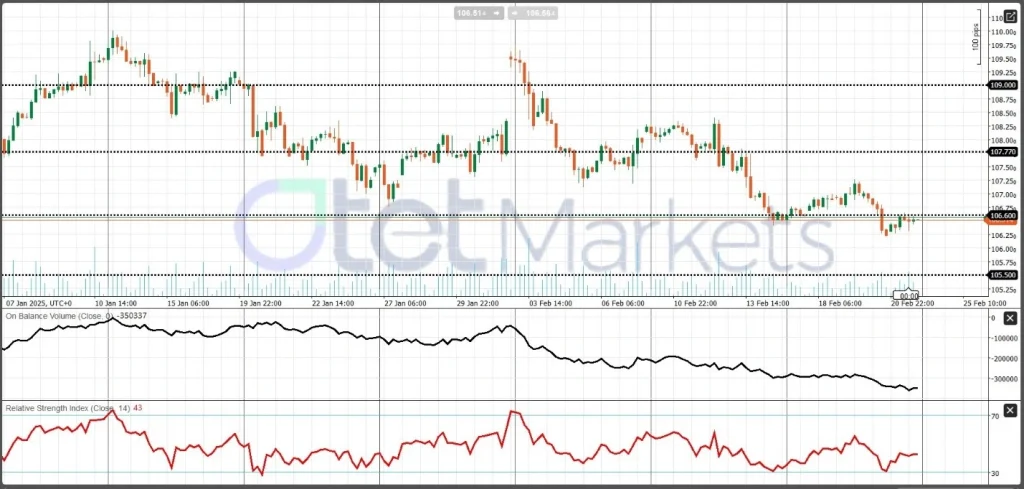
U.S. stocks tumbled on Friday, extending their selloff as weak economic data and tariff concerns weighed on investor sentiment. All three major indexes fell sharply, with the S&P 500 and Russell 2000 recording their worst single-day declines since December 18. For the week, all indexes ended in the red, with the Dow posting its steepest weekly drop since mid-October.
Economic reports revealed slowing business activity and weakening consumer sentiment, compounded by Walmart’s disappointing outlook, which fueled fears of softening demand. Investor uncertainty surged, pushing the CBOE volatility index to its highest level since February 3. Analysts warn that rising uncertainty is now the dominant market narrative, driving increased volatility.
While overall economic data do not favor stock bulls, from a technical perspective, the S&P 500 dropping below 6,000 could shift the direction toward 5,930, with the next support level around 5,870. A break below this level could trigger a more significant decline. On the other hand, holding above 6,000 could keep bulls in play a bit longer, but with RSI and OBV signals weakening, bullish momentum would remain limited to below 6,100.
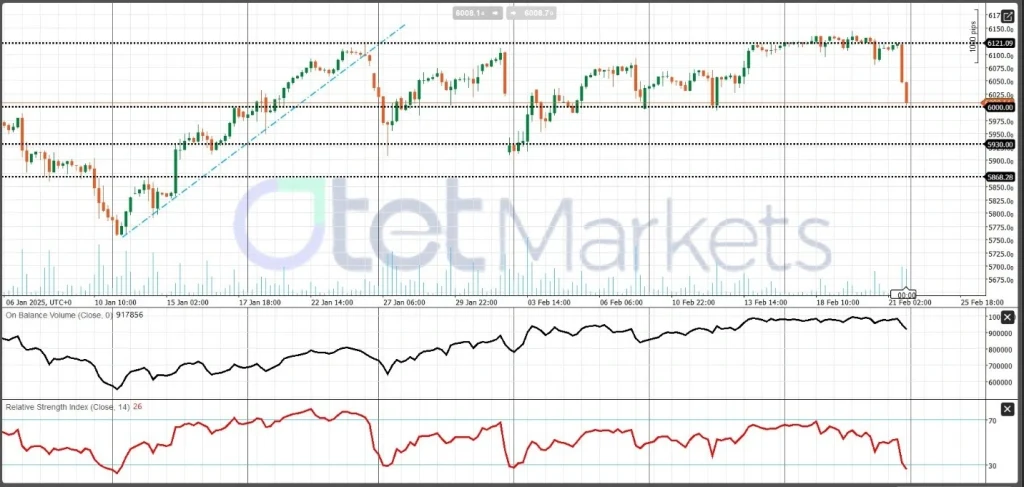
EU and German Elections
The Eurozone PMIs for February indicated moderate economic growth, though concerns remain, with manufacturing still below the 50 expansion threshold. The Eurozone composite PMI held steady at 50.2, just above contraction, with manufacturing improving to 47.3 but services falling to 50.7. Germany’s PMI rose to 51.0, while France’s declined sharply to 44.5. Rising input and output prices suggest inflationary pressures persist.
The German elections on Sunday pose a key risk for the EUR. The CDU is expected to win with around 30%, followed by the far-right AfD at 20%. Since forming a government requires a coalition, market concerns center on whether AfD might be included as a junior partner. Although major parties have pledged to exclude AfD, prolonged coalition negotiations could create political uncertainty, potentially weighing on the EUR. If AfD secures a higher-than-expected vote share, making government formation difficult, the EUR may weaken. Conversely, signs of a stable government forming could support the EUR.
The ECB’s dovish stance is another factor pressuring the EUR. While ECB board member Schnabel hinted at a rate cut pause, which may sound hawkish, the overall sentiment remains dovish. Inflationary pressures persist, and January’s HICP inflation data, due Monday, could confirm this.
On the macroeconomic front, despite improved PMI figures, Germany’s manufacturing sector remains in contraction. Additionally, Trump’s potential tariffs on EU goods add to economic uncertainty. The Eurozone’s economic outlook remains weak, with anemic growth and recession risks looming.
On the monetary front, ECB policymaker Francois Villeroy de Galhau expects the deposit rate to fall to 2% by summer. The ECB recently cut rates to 2.75% and is set for another reduction in March, prioritizing growth concerns over inflation risks.
Overall, political uncertainty, economic struggles, and ECB policy direction will be key drivers for the EUR in the coming weeks.
From a technical perspective, EUR/USD remains above its key pivot at 1.04, and the trend remains bullish. However, a drop below this key level could signal a shift in market direction.
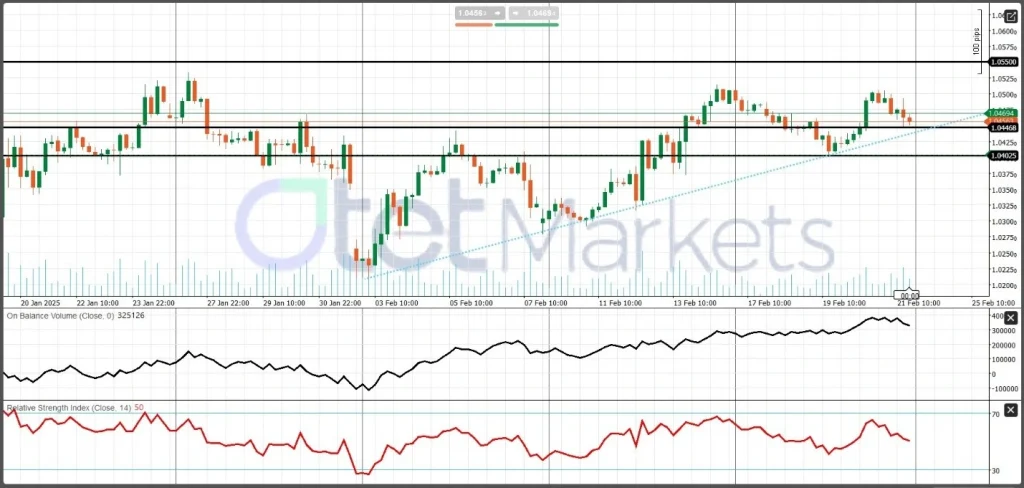
Gold, Geopolitics, Inflation, and Market Scenarios
Gold remains a safe-haven asset, attracting investors during times of economic and geopolitical uncertainty. The U.S. and Russia have agreed to further negotiations on Ukraine, and a fragile truce between Israel and Hamas is in place. If these efforts succeed, reduced geopolitical risk could lower gold demand. However, historical patterns suggest that any resumption of tensions could sustain gold’s rally as investors seek stability.
Higher-than-expected U.S. CPI and labor market data confirm persistent inflation, strengthening gold’s role as a hedge. In addition, renewed tariff threats could further fuel inflation, increasing gold’s attractiveness. Lingering inflation, trade pressures, and central bank stockpiling support a continued gold rally. On the flip side, successful geopolitical resolutions could shift investors toward riskier assets, potentially capping gold’s upside.
Overall, geopolitical uncertainty, inflation, and monetary policies will be the key drivers of gold’s price movement in 2025. Goldman Sachs raised its 2025 target to $3,100, citing strong central bank buying and inflation risks.
From a technical point of view, XAU/USD remains bullish, with the first support at 2,895 and then 2,860.
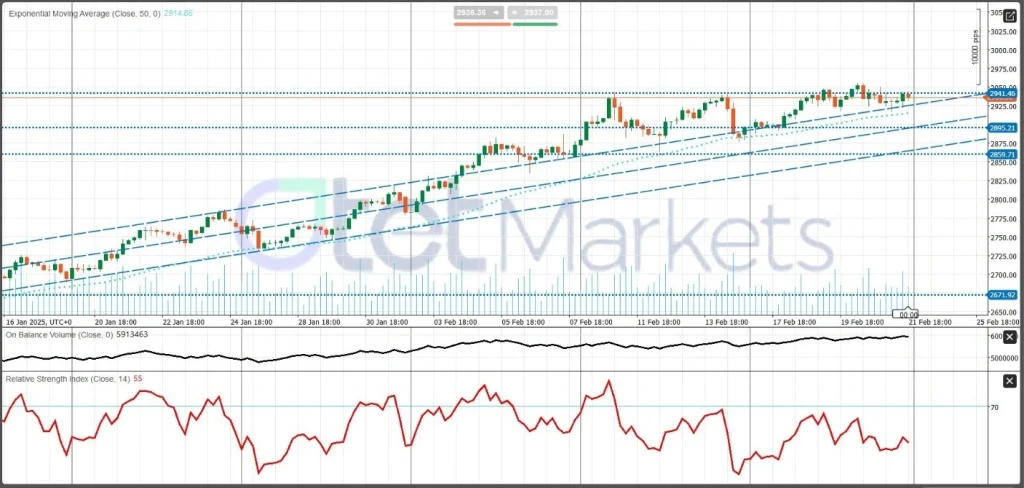
Oil and Energy Market
Oil prices saw gains throughout the week but experienced a significant selloff on Friday, leaving Brent crude flat for the week. Supply uncertainties continue to drive the market, with risks from disruptions in Kazakhstan, weather events in the U.S., and potential sanctions on Russia. The U.S. is pressuring Iraq to restart its pipeline to Turkey, contributing to the price drop.
In North Dakota, extreme cold weather caused a reduction in oil and natural gas production, which is expected to last until the weekend. Meanwhile, the EU imposed new sanctions on Russia, targeting additional vessels in its shadow fleet. These sanctions haven’t significantly reduced export volumes but have led to an increase in floating storage.
The potential resumption of oil flows from Iraq’s Kurdistan region, which could bring 300k b/d of supply, is offsetting some of these risks. Crude oil inventories rose by 3.3 million barrels, and gasoline inventories increased by 2.8 million barrels. However, distillate stocks declined by 2.7 million barrels. The Energy Information Administration’s report also confirmed an inventory increase of 4.633 million barrels in the last week.
President Trump is driving a resurgence in the U.S. energy sector with a proposed tax cut that includes 100% expensing for new factories, incentivizing investment in the U.S. and creating high-paying jobs. This comes alongside the U.S.’s natural gas advantages, with the lowest prices in the industrialized world, further fueling the potential for growth. Previous administration policies, including Biden-era regulations, hindered such investment, but Trump’s focus on deregulation aims to reverse this.
Additionally, the Trump administration recently approved a new Texas oil port, which had been delayed for five years, aiming to improve U.S. energy exports. Oil prices are stable despite a bearish API report, supported by frigid weather across the U.S., impacting production. Meanwhile, increased exports from Russia and Iran are creating tensions, with the Trump administration intensifying pressure on Iran.
The geopolitical situation is also heating up, with Iran facing internal unrest and international calls for action against its regime.
While the overall geopolitical condition remains uncertain, there are increasing supply opportunities. From a technical point of view, the formation of new lower lows and lower highs is raising the chances of a downtrend compared to previous days. The next key support sits at $69; breaching that level could open the doors to much deeper prices.
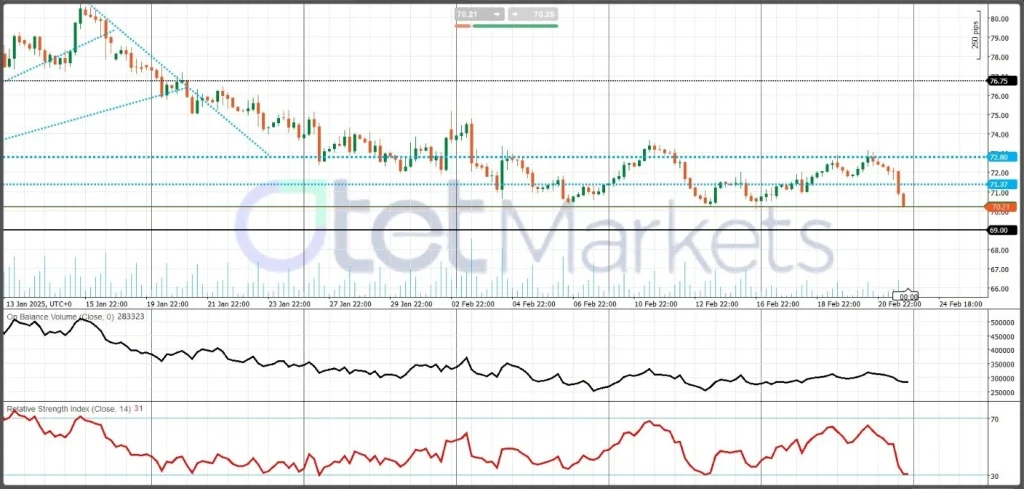
BTC and Week ahead!
Bitcoin (BTC/USD) remains above $94k but faces significant uncertainties. While spot Bitcoin ETFs attracted $5.6 billion in new investments, recent data shows net outflows, indicating a cooling of speculative interest. On-chain data suggests slower capital inflows, and market sentiment shows a decline in demand, particularly in derivatives and riskier assets. This decline parallels broader market trends, with gold rising as a safe-haven asset.
MicroStrategy (now rebranded as Strategy) did not purchase Bitcoin last week but recently raised $2 billion through convertible notes, signaling potential future purchases that could drive a bull run. Despite these moves, the market remains cautious, with reduced speculative trading and lower profits from leveraged positions.
In the coming days, the crypto market will be influenced by regulatory developments, institutional expansion, and broader economic factors. The U.S., under the Trump administration, has taken a crypto-friendly stance, and Europe implemented the Markets in Crypto-Assets (MiCA) framework in January 2025. Asia presents a mixed picture, with Hong Kong embracing crypto exchanges while China tightens regulations.
The increased liquidity brought by institutional investors has contributed to market stability but raised concerns about centralization and regulatory control. With the launch of Bitcoin and Ethereum ETFs, more traditional investors are entering the market, further legitimizing crypto assets.
From a technical perspective, immediate support sits at $97,000 before the key $94,000 level comes back into focus. Key resistance is set at $101,000, while markets will turn their attention toward the $102,157 resistance if it reaches above this key level.
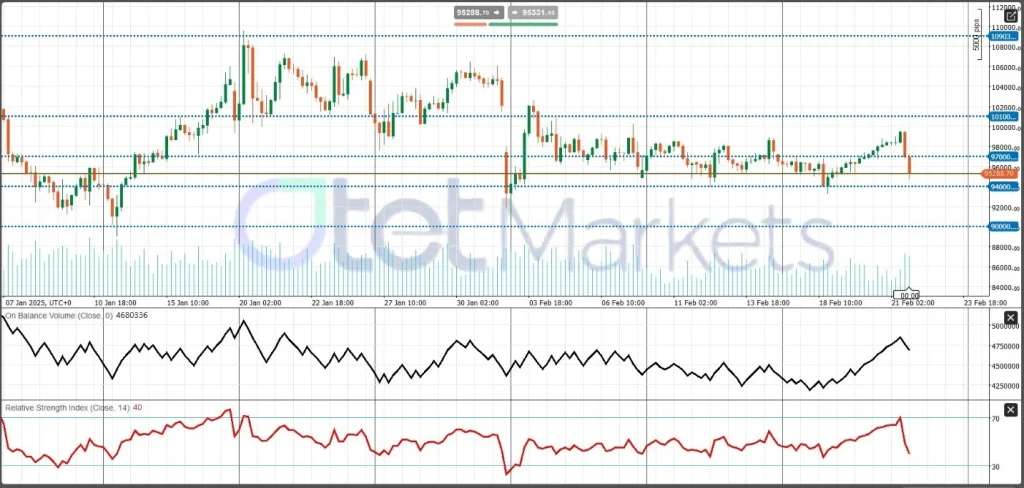
Share
Hot topics
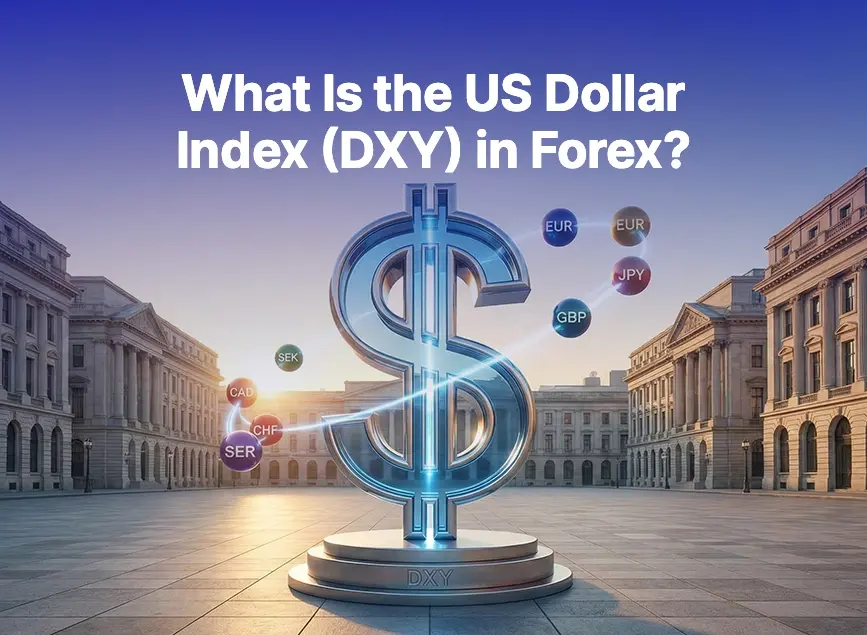
What Is the US Dollar Index (DXY) in Forex?
If you’ve spent any time exploring global markets, you’ve certainly heard about the US Dollar Index, known as DXY. For many beginner traders, it appears to be one of those...
Read more



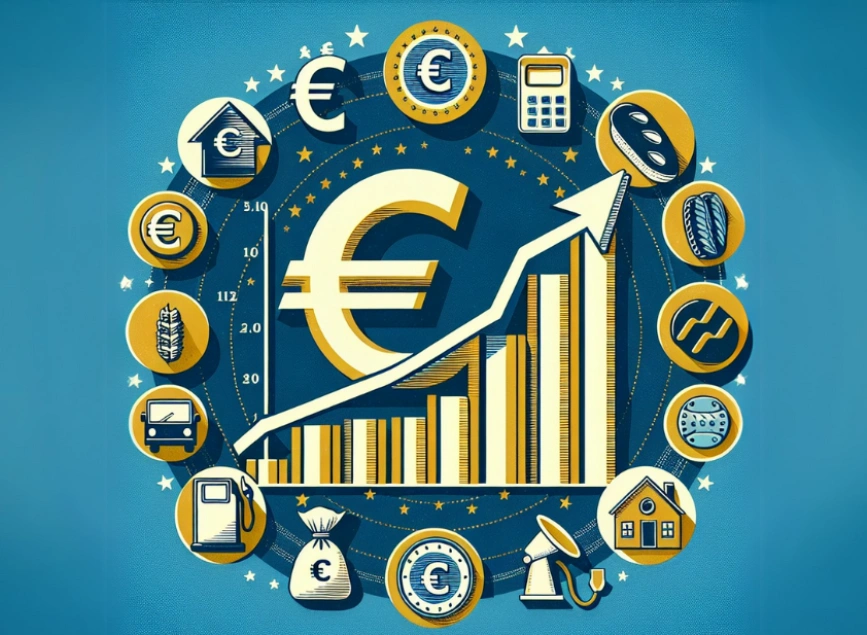
Submit comment
Your email address will not be published. Required fields are marked *